introduction
The porous structure has become an important breakthrough in the rapid response of shape-deformed hydrogels. However, the 3D shapes typically obtained by these porous actuators are monotonous and single. This paper combines the "electrospinning" and " 3D printing " technologies to develop a simple and versatile method to generate 3D design deformable hydrogels with rapid deformation and performance enhancement. The symmetry response is applied to the electrospun membrane having a mesoporous structure to adjust the plane and interlaminar internal stress caused by expansion/contraction, thereby guiding the deformation behavior of the electrospun membrane to adapt to environmental changes. Through this method, a series of rapidly deforming hydrogel actuators possess a variety of unique response behaviors, including reversible/irreversible formation of 3D structures, folding of 3D tubes, and formation of 3D structures with multiple low energy states. It is worth noting that although poly(N-isopropylacrylamide) was selected as the model system for this study, the method is equally applicable to other stimuli-responsive hydrogels, which enriches the application of rapidly deforming hydrogel actuators. prospect.
Summary of results
Recently, Professor Ji Jian of Zhejiang University and Seema Agarwal (Common Newsletter) of Bayreuth University, Germany, published an article entitled "Combining 3D Printing with Electrospinning for Rapid Response and Enhanced Designability of Hydrogel" on Adv. Funct. Mater. Actuators" article. This article describes the use of mesoporous structures for electrospinning thermal-responsive poly(N-isopropylacrylamide) (PNIPAm) membranes as morphogenic substrates with a porous structure to ensure that water temperatures are below and below their critical solution temperatures. (LCST) rapid absorption and desorption when the temperature changes. Different rigid PNIPAm / clay patterns were printed on the PNIPAm film by a 3D printer. Although the responsiveness of the PNIPAm/clay composite compared to the electrospun film is less pronounced, it has a particular effect on guiding the formation of internal stresses that control the shape transition of the substrate. As a model system, PNIPAm is a universal method for many other responsive hydrogels. Compared to other patterning techniques, computer-aided 3D printing technology provides precise control of structure and composition while providing excellent designability. The method creatively combines the advantages of electrospinning and 3D printing to enhance the design of the 3D shape while enhancing the design, providing rapid deformation and simplicity.
Graphic guide
Figure 1 Schematic diagram of preparation of PNIPAm actuator by electrospinning
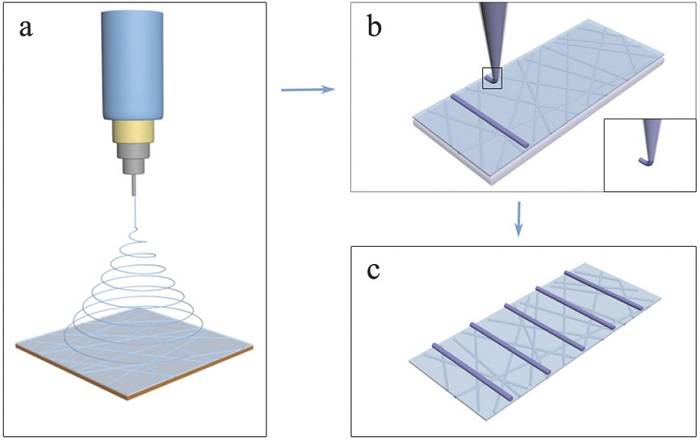
a) UV crosslinking;
b) 3D printing assisted patterning;
c) Schematic diagram of the prepared sample of the simplest pattern.
Figure 2 Sample schematic and its internal stress test
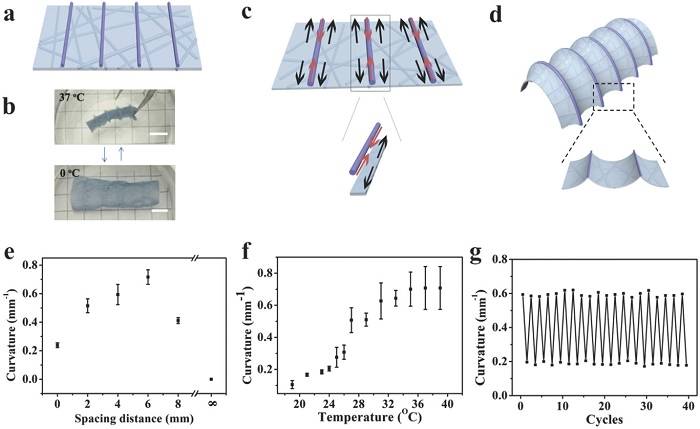
a) a schematic diagram of the preparation of the sample;
b) reversible shape transformation of the prepared sample;
c) Schematic diagram of in-plane internal stress (upward) and inter-layer internal stress (downward) caused by expansion mismatch at 37 °C. Red arrow: stress acting on the printed line; black arrow: stress acting on the electrospinning (NIPAm-ABP) film;
d) an electrospun film bent in water at 37 ° C;
e) the change in curvature at 37 ° C as the distance between the printed lines increases;
f) temperature responsiveness of the sample in water (the distance between adjacent printed lines is 6 mm);
g) Repeatability of shape transition in the heating/cooling cycle (distance between adjacent printed lines is 4 mm).
Figure 3 sample shape deformation process
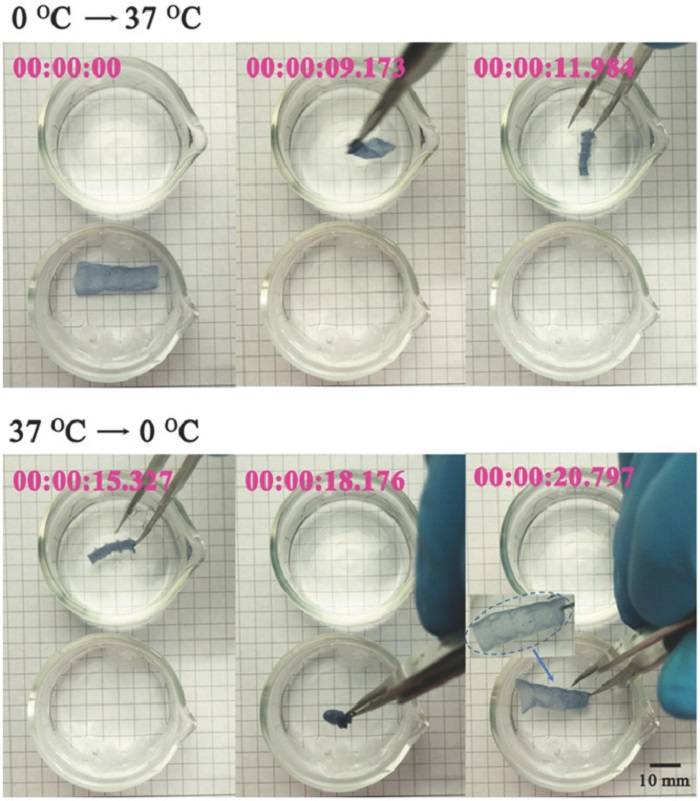
The shape deformation process of the sample when the sample is transferred from 0 ° C to 37 ° C (top) or 37 ° C to 0 ° C (bottom). The time required for the shape transition from 0 ° C to 37 ° C is about 2.8 seconds, while the shape transition from 37 ° C to 0 ° C is about 2.6 seconds.
Figure 4: Shape deformation and temperature response behavior guided by rigid mode
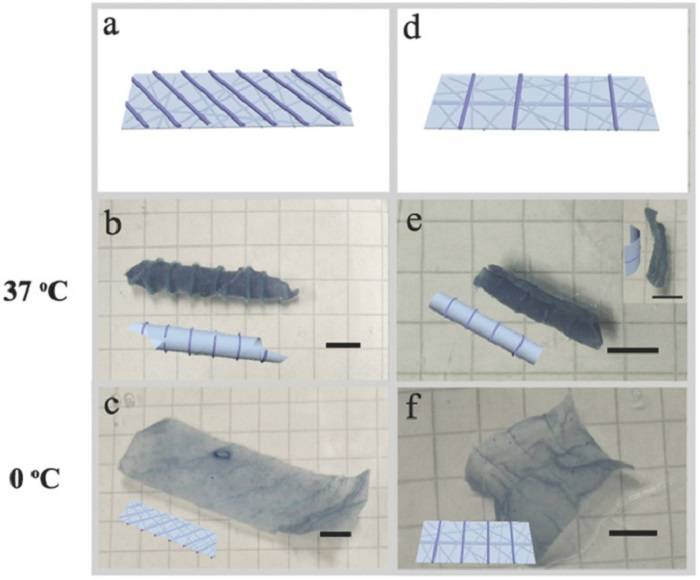
a), d) schematic diagram of different modes;
b)~e) a photograph of a three-dimensional shape obtained in water at 37 ° C;
The inset in e) indicates a stable shape obtained by deforming the sample by an external force at 37 ° C;
c, f) A photograph of a three-dimensional shape obtained in water at 0 °C. Scale bar: 5 mm.
Figure 5 UV-visible absorption spectrum
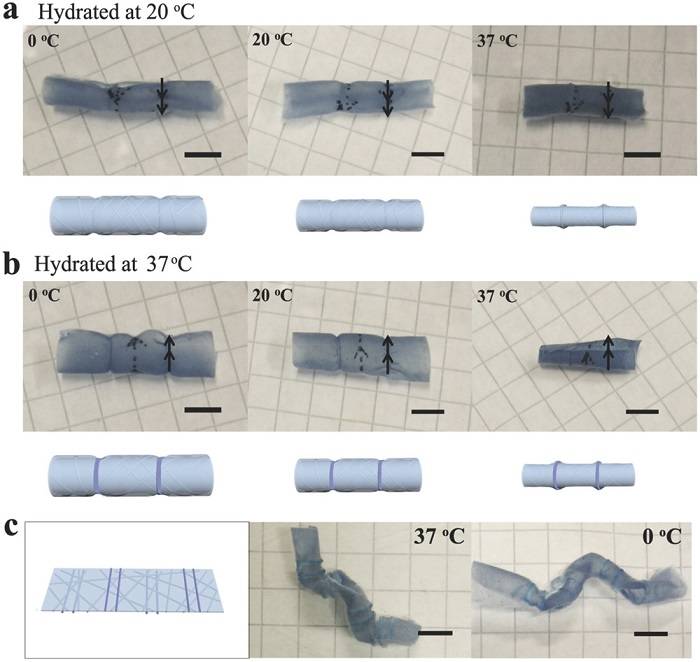
a) the direction of bending of the sample in water at different temperatures;
b) an illustration of the bending direction of the sample first immersed in water at different temperatures in water at 37 ° C;
c) An irreversibly formed folded tube that is thermally actuated by printing a line size on both sides of the electrospun substrate.
summary
The research team designed the fast-response deformation hydrogel by creatively combining electrospinning and 3D printing. Due to the fast mass transfer caused by the porous structure, the electrospun mesostructured substrate provides a fast response, while the rigid pattern created by 3D printing on the substrate provides a means for the formation of 3D structures in the water and its responsiveness. This method is simple and suitable for the preparation of a large number of samples. In addition, although PNIPAm was chosen as the research model in the experiment, such methods can be extended to other responsive hydrogels. It is believed that by combining different types of responsive hydrogels or other activation techniques, many interesting results can be produced in this framework.
Spray Air Freshener,Car Spray Air Freshener,Deodorant For Car,Air Freshener Spray
Comebest , https://www.comebest.com